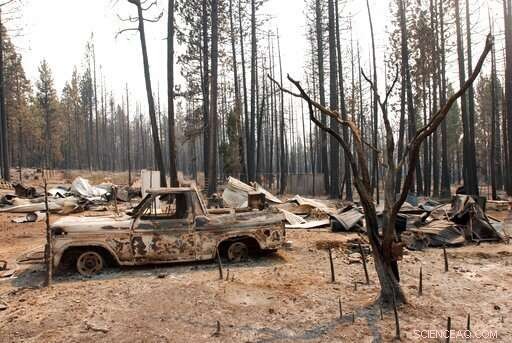
En ce mercredi, 22 août 2012, fichier photo, un camion endommagé se trouve parmi d'autres restes sur un site de maison rurale à l'extérieur de Manton, Californie, où un énorme feu de forêt a brûlé samedi, obligeant les habitants à évacuer. Une analyse McClatchy révèle plus de 350, 000 Californiens vivent dans des villes qui existent presque entièrement dans des « zones de gravité très élevée des risques d'incendie ». (AP Photo/Jeff Barnard, Déposer)
Villes appauvries à l'ombre du mont Shasta. Villes rustiques de la ruée vers l'or dans les contreforts de la Sierra Nevada. Communautés de villégiature haut de gamme sur les rives du lac Tahoe. Banlieue Ritzy du comté de Los Angeles.
Ils pourraient tous être le prochain paradis.
Une analyse McClatchy révèle plus de 350, 000 Californiens vivent dans des villes qui existent presque entièrement dans des « zones de gravité des risques d'incendie très élevés » - la désignation de Cal Fire pour les endroits très vulnérables aux incendies de forêt dévastateurs. Ces désignations se sont avérées étrangement prédictives de certains des incendies de forêt les plus destructeurs de l'État ces dernières années, y compris le feu de camp, le pire de l'histoire de l'État.
Presque tout le paradis est coloré en rouge vif sur la carte de Cal Fire. Pratiquement toute la ville était gravement menacée avant que le feu de camp ne fasse rage en novembre dernier, brûlant la majorité des maisons sur son passage et tuant 85 personnes.
Malibu, où l'incendie de Woolsey a brûlé plus de 400 maisons l'année dernière, fait également partie des zones à très haut risque. Tout comme la petite ville du comté de Lake, Cobb, dont une grande partie a été détruite par l'incendie de la vallée en 2015.
"Il y a beaucoup de paradis là-bas, " dit Max Moritz, un spécialiste des incendies à l'UC Santa Barbara.
En tout, plus de 2,7 millions de Californiens vivent dans des zones à très haut risque d'incendie, des remorques sur des chemins de terre tranquilles dans la forêt aux manoirs dans les plus grandes villes de l'État, selon l'analyse, qui est basé sur les données du recensement de 2010 au niveau des blocs. Le département californien des forêts et de la protection contre les incendies indique que ses cartes montrent des endroits où les incendies de forêt sont susceptibles d'être extrêmes en raison de facteurs tels que la végétation et la topographie.
Les cartes ne sont pas parfaites dans leur capacité à prévoir où un incendie sera destructeur. Par exemple, le quartier Coffey Park de Santa Rosa n'est pas dans une zone à très haut risque, mais des vents puissants ont poussé le Tubbs Fire dans cette partie de la ville, nivelant en grande partie le quartier en octobre 2017.
Coffey Park a été construit « sans aucune considération pour le feu, " a déclaré Chris Dicus, un expert en foresterie et incendie à Cal Poly San Luis Obispo. "Le feu était dans les montagnes - il n'y avait aucune considération que le feu traverserait (l'autoroute) 101."
Cal Fire prépare de nouvelles cartes des risques d'incendie - prêtes dans un an environ - qui intégreront les modèles de vent régionaux et d'autres facteurs climatiques. En attendant, les experts disent que les cartes actuelles, créé il y a une dizaine d'années, fournissent toujours un guide important pour prédire où les feux de forêt pourraient faire le plus de dégâts, de la même manière, les cartes des plaines inondables mettent en évidence les zones qui pourraient être les plus durement touchées lors de violentes tempêtes.

En ce 14 mars, 2019, photo, un lotissement au large de Chief Kelly Drive à Nevada City, Californie, Est en construction. Les villes californiennes continuent de construire des maisons dans des zones à haut risque d'incendie de forêt. Les fonctionnaires de la ville conviennent que les tirages boisés, coteaux escarpés, rues résidentielles étroites, les maisons anciennes et l'épaisse canopée urbaine qui définissent le caractère de la ville la rendent également particulièrement menacée en cas d'incendie. (Hector Amezcua/L'abeille de Sacramento via AP)
Les communautés à risque identifiées par McClatchy devraient également servir de point de départ pour hiérarchiser la manière dont la Californie devrait dépenser de l'argent pour les rénovations et d'autres programmes de sécurité incendie, dit Moritz.
Les codes du bâtiment de pointe de la Californie aident à protéger les maisons contre les incendies de forêt dans les zones les plus vulnérables, les experts disent. Mais les codes ne s'appliquent qu'aux nouvelles constructions. Un projet de loi présenté par le député Jim Wood fournirait de l'argent pour aider les Californiens à rénover les maisons plus anciennes.
"Cela ira un long chemin vers ces différentes municipalités (en montrant) qu'elles méritent un financement, ", a déclaré Moritz.
McClatchy a identifié plus de 75 villes et villages avec des populations de plus de 1, 000 où, comme le paradis, au moins 90 pour cent des résidents vivent dans les "zones de gravité très élevée des risques d'incendie" de Cal Fire.
Voici des instantanés de 10, et les défis uniques auxquels ils sont confrontés :
___
Shingletown :un paradis miniature
Population (2010)-2, 283 ' dans la zone de gravité du risque d'incendie très élevé—2, 283
Shingletown fait moins d'un dixième de la taille de Paradise, mais comporte probablement autant de risques.
Comme le paradis, la communauté non constituée en société se trouve au sommet d'une crête, et est couvert de grands arbres et de broussailles épaisses, ingrédients d'un incendie de forêt majeur. Shingletown s'appelait à l'origine Shingle Camp, pour les ouvriers qui coupaient des lattes de toiture dans le bois pour approvisionner les mineurs à l'époque de la ruée vers l'or.

En ce 14 mars, 2019, photo, le centre-ville de Nevada City est entouré d'une zone boisée dense, ce qui augmente son risque d'incendie. Les fonctionnaires de la ville conviennent que les tirages boisés, coteaux escarpés, rues résidentielles étroites, les maisons anciennes et l'épaisse canopée urbaine qui définissent le caractère de la ville la rendent également particulièrement menacée en cas d'incendie. (Hector Amezcua/L'abeille de Sacramento via AP)
"Nous cultivons des arbres comme si personne n'était ici, " dit Tom Twist, membre du Shingletown Fire Safe Council, une organisation bénévole. Tourner, qui a vécu dans la communauté par intermittence depuis les années 1970, dit que quand le temps sera chaud, il marchera dans sa propriété, arrachant les semis dans un effort presque vain pour éliminer les combustibles potentiels.
"Je arrache 20 ou 30 semis par jour du sol, " dit-il. " C'est presque comme quand je marche là-bas, il y en a 20 ou 30. Quand je reviens, il y en a encore 20 ou 30."
Tout comme le paradis, échapper à la crête dans un incendie rapide ne serait pas facile; La rue principale de Shingletown est sinueuse, étroite route 44. Et, comme au paradis, la présence d'une population plus âgée rendrait l'évacuation plus difficile; L'âge médian de Shingletown est de 61 ans, selon les chiffres du recensement.
Il n'est pas étonnant que lorsque le gouverneur Gavin Newsom a ordonné à Cal Fire d'élaborer une liste de projets urgents de sécurité incendie, un plan pour tailler 1, 124 acres de végétation le long de l'autoroute 44 sont devenus la priorité absolue sur 35 projets dans l'État.
Les habitants se disent heureux que l'État prête attention à un problème qu'ils connaissent trop bien. La communauté a dû évacuer lorsque l'incendie de Ponderosa, commencé par un coup de foudre, touché en 2012. L'incendie a brûlé 27, 676 acres - 43 miles carrés - et incendié 52 maisons dans les environs.
"Nous sommes intimement conscients des dangers ici, " dit Twist.
___
Nevada City :pittoresque et risquée
Population (2010)—3, 068 ' dans la zone de gravité très élevée du risque d'incendie-3, 064
Depuis le feu de camp, Vicky Guyette a considéré la parcelle d'un acre de broussailles non taillées derrière la maison de l'époque victorienne de sa mère à Nevada City comme plus qu'une simple nuisance sans attrait.

En ce 24 mars, 2019, photo, Gene Mapa collectionne des objets en métal et en céramique qui n'ont pas brûlé dans le feu de camp de sa maison à Paradise, Californie Mapa vit maintenant à Colfax, ce qui représente un niveau similaire de risque d'incendie. Un ancien centre d'approvisionnement pour les camps d'extraction d'or, Colfax se trouve à quelques kilomètres de la lisière de la forêt nationale de Tahoe, dans la Sierra à basse altitude. Il chevauche l'Interstate 80 et sert de dernier arrêt majeur entre la zone métropolitaine de Sacramento et la région du lac Tahoe. Les chevaux paissent à côté des cerfs dans de grandes ranchettes dans les canyons accidentés et broussailleux à la périphérie de la ville. (Hector Amezcua/L'abeille de Sacramento via AP)
Maintenant, la brosse est menaçante, une source d'inflammation qui pourrait incendier la maison construite en 1859 dans laquelle sa famille vit depuis cinq générations.
La même inquiétude s'applique aussi aux cèdres, pins et broussailles recouvrant les collines autour de cette ville de contrefort d'environ 3, 100 personnes, dont beaucoup vivent ou travaillent dans des bâtiments en bois datant de l'ère de la ruée vers l'or.
"C'est très effrayant, surtout que c'est une si jolie petite ville que j'ai vécue toute ma vie, " Guyette a déclaré récemment alors qu'elle marchait dans l'historique Broad Street de la ville, on dirait qu'il est tombé d'une photo d'une exposition de musée.
Les fonctionnaires de la ville conviennent que les tirages boisés, coteaux escarpés, rues résidentielles étroites, les maisons anciennes et l'épaisse canopée urbaine qui définissent le caractère de la ville la rendent également particulièrement menacée en cas d'incendie.
« Le plus grand risque de la ville du Nevada pour la vie humaine et les pertes financières est le feu, " Le plan d'atténuation des risques de Nevada City lit.
Au cours des dernières décennies, la ville a également eu quelques quasi-accidents avec le feu, y compris un appel rapproché majeur.
En 1988, des vents violents ont poussé le 49er Fire à travers 52 miles carrés de l'ouest du comté du Nevada, brûler 312 bâtiments et des dizaines de voitures.
"À l'époque, c'était considéré comme un événement anormal, " a déclaré Billy Spearing du Fire Safe Council du comté de Nevada. " Ce n'était pas normal pour eux à l'époque. "
Avec de tels incendies devenant la nouvelle norme, Cal Fire envisage de couper un 1, Coupe-feu de 802 acres dans le sud-ouest du comté du Nevada sur un terrain qui n'a pas brûlé depuis un siècle, aider à protéger à la fois Nevada City et la communauté adjacente de Grass Valley, abrite plus de 12, 000.
Nevada City a également lancé une campagne en ligne "Goat Fund Me" pour collecter 25 $, 000 pour embaucher des agriculteurs pour qu'ils utilisent leurs chèvres pour manger des broussailles denses dans plus de 450 acres de ceinture verte appartenant à la ville.
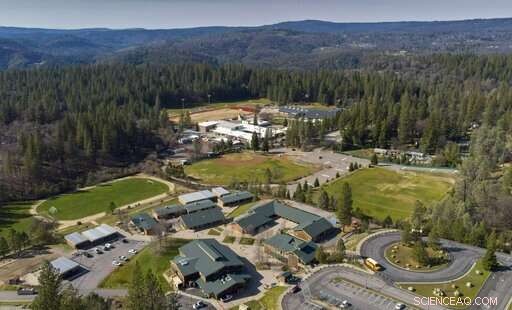
En ce 14 mars, 2019, photo, Colfax, Calif.'s elementary and high schools are surrounded by trees but could become a safe zone in the event of a wildfire similar to the one that destroyed Paradise. A former supply hub for gold mining camps, Colfax sits a few miles from the edge of the Tahoe National Forest in the lower-elevation Sierra. It straddles Interstate 80 and serves as the last major stop between the Sacramento metropolitan area and the Lake Tahoe region. Horses graze beside deer on large ranchettes in the rugged brushy canyons along the outskirts of the city. (Hector Amezcua/The Sacramento Bee via AP)
The goats recently chewed a swath through Pioneer Park near Margaret Rodda's Victorian home, which sits on a steep draw above a creek. But she's still worried.
"All it takes is a drunk with a cigarette, " elle a dit.
The goats inspired Guyette. She said she might spend the $500 to put a herder's goats to work on the thorny thicket of blackberries behind her mother's house.
"We need to get rid of them, " elle a dit.
__
Colfax:Fire is on everyone's minds
Population (2010)—1, 963 ' In Very High Fire Hazard Severity Zone —1, 963
On his first full day in office, Newsom visited the Cal Fire station in Colfax to announce new initiatives on wildfire safety. As he spoke to reporters, surrounded by first responders, he was standing in a city that could burn any summer.
"The people who live here have a true understanding, " said Colfax City Manager Wes Heathcock. "It's always on the back of people's minds, especially with the most recent fires, the Camp Fire. We have a similar makeup here."
At night in the summer, Aimee Costa, who lives on a hill above the elementary school, sometimes keeps her window open, the better to hear ominous sounds.

In this 2007 photo, men clear debris after the Angora Fire destroyed hundreds of Tahoe-area homes south of Kings Beach, Calif. Situated on the pristine north shore of Lake Tahoe, Kings Beach is one of the most heavily visited vacation spots in Northern California. That's a big part of the problem. Because so much of the population comes and goes, it becomes harder to get people to treat wildfire risk with the respect it deserves. (Paul Kitagaki Jr./The Sacramento Bee via AP)
"You're laying in bed . listening for that lick, that smack, that pop sound, " Costa said, describing the sound flames would make if they were chewing pine needles, brush and leaves.
A former supply hub for gold mining camps, Colfax sits a few miles from the edge of the Tahoe National Forest in the lower-elevation Sierra. It straddles Interstate 80 and serves as the last major stop between the Sacramento metropolitan area and the Lake Tahoe region. Horses graze beside deer on large ranchettes in the rugged brushy canyons along the outskirts of the city.
The terrain poses a major fire risk.
In July 2015, the Lowell Fire erupted near Colfax and chewed up thousands of acres along the north side of the freeway, forcing evacuations in adjacent Nevada County. In the years since, Heathcock said the city has been working with state officials on "fuelbreak" projects, including a spot near the high school and elementary school, which has been eyed as an evacuation site.
Gene Mapa, who lived in Paradise and escaped the Camp Fire with some family photographs—and nothing else—has relocated to Colfax, where he already owned a second home. But he knows he hasn't escaped the fire risk; his property just outside the city limits would be threatened by a windy firestorm like the one that engulfed Paradise.
"With that wind, there would be no stopping it anywhere, " Mapa said.
__
Kings Beach:Tourists seek fun, bring fire danger
Population (2010)—3, 796 ' In Very High Fire Hazard Severity Zone —3, 796
Situated on the pristine north shore of Lake Tahoe, Kings Beach is one of the most heavily visited vacation spots in Northern California.

In this Sept. 15, 2014, fichier photo, a jet drops a load of fire retardant near Highway 50 in El Dorado County near Pollack Pines, Calif. Memories are still vivid of the Sand Fire in 2014. That fire burned 4, 200 acres and 20 homes and came dangerously close to forcing a major evacuation in Pollock Pines and surrounding communities. (Randy Pench/The Sacramento Bee via AP)
That's a big part of the problem.
Because so much of the population comes and goes, it becomes harder to get people to treat wildfire risk with the respect it deserves, said Erin Holland, a spokeswoman for the North Tahoe Fire Protection District. One of the district's six stations is in Kings Beach.
"It is definitely a challenge because we have so many homes that are vacation homes, " she said. "It's really a challenge to educate those visitors . They want to have a camp fire."
Tahoe's vulnerability to major fires was brought home dramatically in recent years. The Angora Fire in 2007, while it was confined to the south shore area, left physical and emotional scars on the entire basin after burning through 3, 100 hectares.
Holland said getting the region's property owners and visitors to observe "defensible space" regulations is particularly difficult. Those rules call for clearing brush 100 feet around buildings and include stricter rules regarding vegetation immediately adjacent to structures.
Violators can be subject to citations, but "the goal is to really educate people, to get people complying, " Holland said. "We go the education route rather than the citation route."
__
Pollock Pines:Do the transplants get it?
Population (2010)—6, 877 ' In Very High Fire Hazard Severity Zone—6, 533
Just off Highway 50, a few miles from the tourist haven of Apple Hill, Pollock Pines lures transplants from coastal California, mainly retirees drawn to the lovely stands of trees in the foothill community at the edge of the Eldorado National Forest.
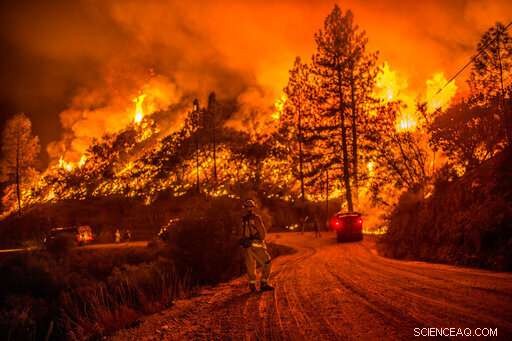
In this 2015 photo, fire crews run controlled burns at night to contain the Butte Fire near Arnold, Calif. In the community that serves as gateway to Calaveras Big Trees State Park, residents didn't always applaud when officials began mapping plans to thin dense stands of trees to reduce fire risk. "Arnold resisted this for a long time because people love their trees, " said Steve Wilensky, a former Calaveras County supervisor who works with nonprofits to improve fire safety in the Sierra. (Andrew Seng/The Sacramento Bee via AP)
Heather Campbell only wishes the newbies had a better understanding of what all that timber represents.
Campbell, a retired U.S. Forest Service employee who's lived in Pollock Pines since the 1990s, is the head of the Pollock Pines-Camino Fire Safe Council, a volunteer group.
In the past few years her organization has received hundreds of thousands of dollars in grants, mainly from the state's "cap and trade" carbon trading program, to trim vegetation on the ridgeline south of Highway 50.
That's all well and good, elle a dit, but more needs to be done. And the people of Pollock Pines, including the newcomers, have to realize what's at stake.
"Here, everybody allows all the saplings and brush to grow and they don't weed it out, " she said. "All these roads are incredibly dangerous, when it's so easy to take out pruners. Take out your pruners!"
She said memories are still vivid of the Sand Fire in 2014. That fire burned 4, 200 acres and 20 homes and came dangerously close to forcing a major evacuation in Pollock Pines and surrounding communities.
"They were going to evacuate 9, 000 personnes, " she said. "They were predicting the fire to go to 27, 000 hectares, instead of the 4, 000 they stopped it at."
__
Arnold:Trees are falling in Big Trees country
Population (2010)—3, 843 ' In Very High Fire Hazard Severity Zone—3, 843

En ce lundi, Aug. 18, 2014, fichier photo, smoke rises from a fire in Wofford Heights, Calif. The same powerful desert gusts that attract wind surfers to Kern County's Lake Isabella make the lakeside community of Wofford Heights particularly at risk for wildfire. So does the adjacent Sequoia National Forest, which has been plagued by drought and tree-killing beetles. (Casey Christie/The Bakersfield Californian via AP, Déposer)
In the community that serves as gateway to Calaveras Big Trees State Park, residents didn't always applaud when officials began mapping plans to thin dense stands of trees to reduce fire risk.
"Arnold resisted this for a long time because people love their trees, " said Steve Wilensky, a former Calaveras County supervisor who works with nonprofits to improve fire safety in the Sierra.
After years of protests, Arnold's residents got a major wake-up call in 2015. The Butte Fire, caused by power lines, took out 549 homes in nearby communities. Two people died.
"If the weather hadn't changed, they'd be gone, " Wilensky said of Arnold. "You've got a real parallel with Paradise in some ways . It's a place that is really highly threatened."
Arnold sits on a ridge, surrounded by a dense forest of drought- and beetle-killed trees. Powerful wind gusts can funnel fire up rugged brushy canyons.
A key difference between Paradise and Arnold is that as many as 45 percent of the dwellings are vacation homes, which can sometimes make it a challenge to get out-of-town homeowners to do brush clearing, ont déclaré des responsables locaux.
Wilensky said momentum to reduce fire risk has built since the Butte Fire. More than $15 million in state and federal funds have gone to thinning dangerous overgrowth in the region, Wilensky said.
One project includes using bulldozer lines that were cut during the Butte Fire to expand a fire break that stretches to town.
"Arnold is the anchor end of this project, " Wilensky said.
__
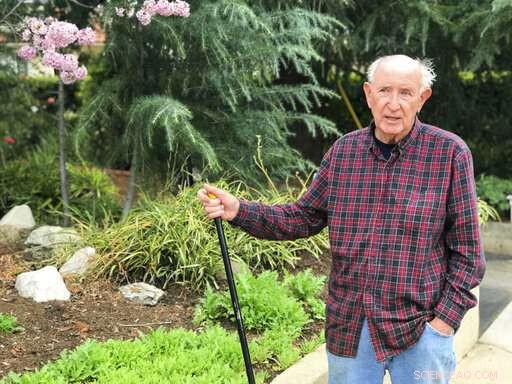
In this March 20, 2019, photo, Thomas Caswell talks about living on his La Canada Flintridge street for four decades. He said he loves his community, but he has no illusions about the threat of a fire funneling down from the nearby Angeles National Forest. "When it comes down the hill, " il a dit, "nobody is going to be safe." (Ryan Sabalow/The Sacramento Bee via AP)
Wofford Heights:Apathy in a danger zone?
Population (2010)—2, 201 ' In Very High Fire Hazard Severity Zone—2, 147
The same powerful desert gusts that attract wind surfers to Kern County's Lake Isabella make the lakeside community of Wofford Heights particularly at risk for wildfire. So does the adjacent Sequoia National Forest, which has been plagued by drought and tree-killing beetles.
Yet some feel that the region isn't doing nearly enough to combat the threat.
"We could do a hell of a lot more than we're doing, " said Judy Hyatt, who lived in the area for 15 years and served as president of the region's fire safe council. The volunteer group disbanded in recent years from what she and others described as a lack of interest.
En 2016, the Lake Isabella region suffered through the Erskine and Cedar fires, which burned more than 77, 000 acres and more than 300 structures. An elderly couple was killed when they were trapped by the Erskine Fire.
According to census figures, the median age of those living in Wofford Heights is 62, and many live in places with poor escape routes.
"Some of those mobiles up there, honest to God, I think they've dropped them out of the sky, " Hyatt said. "The roads are so narrow, and it really just presents an obstacle and the only way to really get to it is by air. That is when people start to die."
Hyatt said the loss of the nonprofit Kern River Fire Safe Council she once headed doesn't bode well for the community. She said the council organized wood-chipping drives to encourage residents to remove wood debris and sought grants for fuel breaks and other thinning projects.
She said too many locals have grown complacent.

En ce lundi, 22 août 2016, fichier photo, workers cut brush off Highway 155, west of Wofford Heights, Californie, as part of fuel reduction for the Cedar Fire. The same powerful desert gusts that attract wind surfers to Kern County's Lake Isabella make the lakeside community of Wofford Heights particularly at risk for wildfire. So does the adjacent Sequoia National Forest, which has been plagued by drought and tree-killing beetles. (Casey Christie/The Bakersfield Californian via AP, Déposer)
"Fire prevention is a nebulous thing, " she said. "It's hard to quantify, until there's a damned fire that takes out everything."
__
La Cañada Flintridge:Is aggressive fire prevention enough?
Population (2010)—20, 048 ' In Very High Fire Hazard Severity Zone—20, 048
Carol Settles and her family evacuated their home in La Cañada Flintridge during the Station Fire in 2009. But she isn't terribly worried about a repeat performance—even though her home is on a dead-end street below a brushy hillside of the Angeles National Forest. Large electrical transmission lines run along the wooded draw behind her home.
"We've never seen a spark, " Settles said, referring to the power lines. "We've never seen any of that."
Best-known as home to NASA's Jet Propulsion Laboratory on the outskirts of Pasadena, the upper middle-class city has an aggressive fire-prevention program. The Los Angeles County fire department checks properties in Settles' area once a year to make sure vegetation has been cleared and hazardous landscaping hasn't been planted.
Fines can be issued for non-compliance. Récemment, one of Settles' neighbors had to saw off the top of a pine tree because it was too close to a transmission tower, elle a dit.
Los Angeles County's assistant fire chief, J. Lopez, said La Cañada Flintridge has embraced rigorous fire-safety standards, which include annual landscaping inspections and stringent fire-safe building codes, even for large home remodels. Lopez said La Cañada Flintridge also chose to place the entire city inside a high fire hazard zone, going beyond the recommendation of Cal Fire. That decision translates into citywide enforcement of its fire-resilient building codes.
"That's a very progressive way to look at it, " a déclaré Lopez.

In this March 22, photographies 2019, a newer home sits along a ridge above Harbison Canyon in San Diego County, Calif. Every 30 years or so, a massive fire blows through Harbison Canyon, 30 miles northeast of San Diego. The 1970 Laguna Fire destroyed much of the unincorporated town that sits inside the canyon and shares its name. Harbison Canyon was rebuilt again after the Cedar Fire burned through in 2003, destroying 287 of the 388 homes. (Ryan Sabalow/The Sacramento Bee via AP)
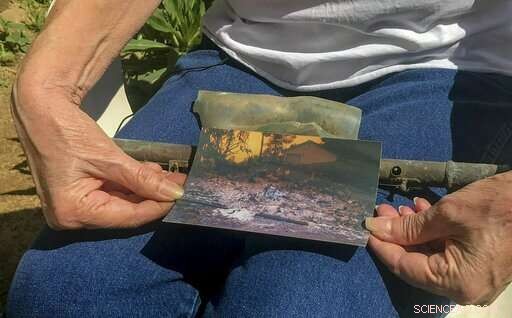
In this March 22, 2019, photo, Cheri Skipper, a Harbison Canyon resident, holds her burned flute and a picture showing what her home looked like after it burned during the Cedar Fire in 2003. Every 30 years or so, a massive fire blows through Harbison Canyon, 30 miles northeast of San Diego. The 1970 Laguna Fire destroyed much of the unincorporated town that sits inside the canyon and shares its name. Harbison Canyon was rebuilt again after the Cedar Fire burned through in 2003, destroying 287 of the 388 homes. (Ryan Sabalow/The Sacramento Bee via AP)
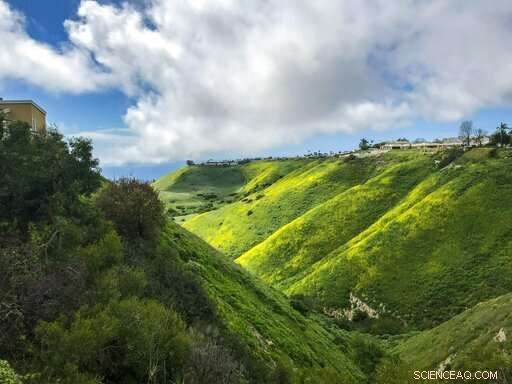
In this March 21, 2019, photo, homes line one of the canyons in Rancho Palos Verdes, Calif. The many acres of open space in the city provide breathtaking views and public access to wild places between city subdivisions, but the vegetation poses a substantial fire risk. Rancho Palos Verdes holds a dubious honor:It's the most populated city in California to have 90 percent or more of its population living within a "very high fire hazard severity zone." (Ryan Sabalow/The Sacramento Bee via AP)/The Sacramento Bee via AP)

En ce lundi, Aug. 20, 2012, fichier photo, a DC-10 drops fire retardant on the Ponderosa Fire near Paynes Creek, Calif. A McClatchy analysis reveals more than 350, 000 Californians live in towns and cities that exist almost entirely within "very high fire hazard severity zones." (Andreas Fuhrmann/The Record Searchlight via AP, Déposer)

En ce mardi, Nov. 4, 2003, fichier photo, President George W. Bush views fire damage with San Diego County supervisor Dianne Jacob during a tour of Harbison Canyon, outside of San Diego. Every 30 years or so, a massive fire blows through Harbison Canyon, 30 miles northeast of San Diego. The 1970 Laguna Fire destroyed much of the unincorporated town that sits inside the canyon and shares its name. Harbison Canyon was rebuilt again after the Cedar Fire burned through in 2003, destroying 287 of the 388 homes. (AP Photo/Charles Dharapak, Déposer)
But since 2008, on average only about a dozen new homes have been built in La Cañada Flintridge each year, meaning most of the housing stock was built before the rigorous fire standards were in place.
The city's hazard mitigation plan notes many of those older homes still have "combustible roofing, open eaves, combustible siding, " and they're on "steep, narrow, poorly signed" roads that make evacuations dangerous.
Thomas Caswell, who's lived for four decades on a hilly, narrow, dead-end street not far from city hall, said he knows the greenbelt behind his house where he watches possums, birds and other wildlife also makes the community vulnerable to fire. It's why he says he didn't mind paying when the city told him he needed to hire a tree service to remove dying trees in his front yard.
Toujours, he knows such efforts probably wouldn't do much good if the Santa Ana winds pushed a fire into the city. Fire officials said that La Cañada Flintridge could have burned in the Station Fire if the Santa Ana winds hadn't stopped blowing. The fire burned 89 homes in outlying communities and 160, 577 acres of forested lands, the largest fire by land mass in Los Angeles County history.
"Once it comes down the hill, " Caswell said, "nobody is going to be safe."
__
Rancho Palos Verdes:Few fears in an affluent suburb
Population (2010)—41, 803 ' In Very High Fire Hazard Severity Zone—40, 550
Rancho Palos Verdes holds a dubious honor:It's the most populated city in California to have 90 percent or more of its population living within a "very high fire hazard severity zone." But few residents seem to think their suburb is in the same league as Malibu, where hundreds of homes burned last fall just up the Los Angeles County coastline.
"It's not like living in Malibu, definitely, " said Gregory Lash as he strolled through a public access walkway in the Trump National Golf Club with his wife, Vivian, on the way to an oceanside park where a pod of dolphins and whales were breaching.

In this March 21, 2019, photo, Michael Choi, the owner of Fire Grazers Inc., adjusts a goat pen in Rancho Palos Verdes, Californie, on a rainy day. The city paid Choi $100, 000 for his goats to eat vegetation on about 60 acres over the course of three months. The goats reduce fire risks around homes. Rancho Palos Verdes holds a dubious honor:It's the most populated city in California to have 90 percent or more of its population living within a "very high fire hazard severity zone." (Ryan Sabalow/The Sacramento Bee via AP)
Il ajouta, moments later:"Hope that's not naive."
City officials say it's not.
"This being a coastal community, we don't get the type of brush and that kind of fire behavior that you might get in somewhere like Paradise, " said Scott Hale, an assistant fire chief for Los Angeles County. The county leads firefighting efforts on the Palos Verdes Peninsula, whose four affluent communities all fall inside a high fire severity zone.
Locals point out that over the years, the firefighters at the five stations on the peninsula have quickly knocked down the relatively small fires that popped up.
Toujours, Rancho Palos Verdes' hazard mitigation plan lists wildfire as a bigger threat to the city than earthquakes, tsunamis et glissements de terrain. Powerful winds that blow from the coast could funnel a fire up the greenbelts that cut through the peninsula's neighborhoods, many of which have opulent homes perched above canyons.
Much of that open space has been preserved by the Palos Verdes Peninsula Land Conservancy, which manages more than 1, 600 acres of land in and around the city. Residents such as Lash love the 42 miles of trails on conservancy lands, but all that undeveloped acreage could ignite, said Gabriella Yap, deputy city manager.
"You're trying to preserve that, but it also comes with fire risk, " Yap said.
The city's staff supports Southern California Edison's plans to trim vegetation from under the lines that run through some of the open space to reduce fire threats, but the land conservancy is bristling at the loss of native habitats.
"The environmental impact of that is really significant, " said Adrienne Mohan, the conservancy's executive director.
__

In this March 21, 2019, photo, Adrienne Mohan, the executive director of the Palos Verdes Peninsula Land Conservancy, stands above acreage her organization maintains in Rancho Palos Verdes, Calif. Rancho Palos Verdes holds a dubious honor:It's the most populated city in California to have 90 percent or more of its population living within a "very high fire hazard severity zone." But few residents seem to think their suburb is in the same league as Malibu, where hundreds of homes burned last fall just up the Los Angeles County coastline. (Ryan Sabalow/The Sacramento Bee via AP)
Harbison Canyon:Will it burn a third time?
Population (2010)—3, 841 ' In Very High Hazard Fire Severity Zone—3, 841
Every 30 years or so, a massive fire blows through Harbison Canyon, 30 miles northeast of San Diego.
The 1970 Laguna Fire destroyed much of the unincorporated town that sits inside the canyon and shares its name. Harbison Canyon was rebuilt again after the Cedar Fire burned through in 2003, destroying 287 of the 388 homes.
Rick Halsey of the Chaparral Institute said the canyon is a painful example of how development has been allowed to continue practically unchecked for decades into some of California's most fire-prone places.
"You want to create a geographical hotspot for fire, you couldn't put it in a better place, " said Halsey, whose environmentalist organization was founded to fight calls for clearing hundreds of square miles of wild lands following the Cedar Fire. "It's like a bowling alley for the Santa Ana winds."
That sort of talk makes longtime resident Mary Manning cringe.
She worries that focusing on the canyon's fire risk creates the impression that the community she loves can't be saved from the next catastrophe. She said her community could be made more safe if state and local officials would invest in infrastructure and fire prevention that matched the rates of development she's seen over the years. Par exemple, the side streets in Harbison Canyon are narrow. Certains, like Manning's, remain unpaved despite decades of building.
"There were five houses, now there are 35, " she said of the street she's lived on since 1975.
Manning notes it was only two years ago that the local fire station became staffed 24 hours a day—14 years after the Cedar Fire. Inside the station, Dave Nissen, the Cal Fire official who oversees firefighting in the area, said there are a number of challenges to fighting a fire in the canyon, including the narrow roads and houses stacked close together.
Nissen said firefighters reduce the risks by inspecting lots every year to make sure they're not overgrown. On that front, Harbison Canyon's residents don't seem to need too much prodding, judging from the roar of chain saws and weed trimmers echoing through the canyon on a recent spring weekday afternoon.
© 2019 La Presse Associée. Tous les droits sont réservés.